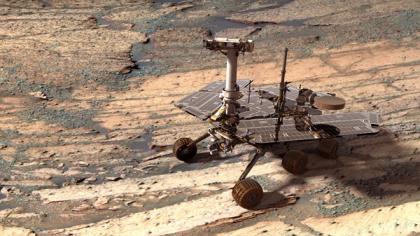 Science and Weather
Science and WeatherOpportunity rover finds evidence of ‘drinkable’ water on Mars
The Mars Opportunity rover has uncovered even more evidence that the Red Planet was once more of a blue world like our own, as scientists working with the mission announced that it had found evidence that there was what they called 'drinkable' water on the surface in Mars' past.
The announcement came on Friday, as the Mars Exploration Rovers team met with the press to discuss Opportunity findings from a rock called Esperance, located at 'Cape York', on the lip of the 'Endeavor Crater'. Last month, Opportunity scratched beneath the surface of this rock to get a clear view at its insides, and then used the spectrometer on the end of its arm to get a good look at what the rock was made of and what the conditions were on Mars' surface when the rock was formed.
[ Related: Mars rover Opportunity nears nebulous off-planet driving record ]
Scientists with the team went over the results and found that the rock contained clay, and although clays can form in acidic water, the evidence showed that the water that affected Esperance was neutral in pH, more like drinking water. pH is the scale used to talk about how acidic or basic something is. Acids like sulphuric acid are very low on the scale. Bases like chlorine bleach are very high on the scale. Either is very damaging to most forms of life. When you're in the middle of the scale, though, like normal drinking water is, that's a much easier place to live.
Findings by both Spirit and Opportunity, shortly after landing, showed evidence for water, but with a much higher acid content. These latest findings at Endeavor Crater are much more favourable.
"What we have here is a very different chemistry," Steve Squyres, the lead scientist for the Opportunity and Spirit teams, said during the meeting on Friday, according to Discovery News. "This is water you can drink. This is water that was probably much more favorably in its chemistry, in its level of acidity, for things like pre-biotic chemistry, the kind of chemistry that could lead to the origin of life."
"This is the most powerful evidence for neutral chemistry water that has been found by Opportunity," he added.
Other findings by Opportunity include the first complete temperature profile of the Martian atmosphere (very useful for Mars science and for any future human missions to the planet), the discovery of Martian 'blueberries', which are tiny spheres embedded in Martian rocks, and also hematite, both of which point towards formation in water, and it has even photographed Martian eclipses (as Phobos and Demos transited across the Sun), as well as taking a picture of Earth from the Martian surface.
[ More Geekquinox: Canada welcomes back astronaut Chris Hadfield ]
Every time I hear more news about Opportunity, I'm amazed that this spunky little robot rover is still going strong after more than nine years on the surface of Mars, and not only that, it's still making amazing discoveries after all that time.
The rover certainly isn't done yet, either, as it's headed off to yet another destination called 'Solander Point'. This latest journey not only promises more discoveries at it's end, but will also earn Opportunity the title of 'farthest off-world driver'. It already broke the record set for farthest off-world distance driven by a human, and it's quickly approaching the record set by the Russian lunar rover Lunokhod 2. Not a bad way to celebrate your 10th anniversary.
(Images courtesy: NASA/JPL/Cornell)
Geek out with the latest in science and weather.
Follow @ygeekquinox on Twitter!




